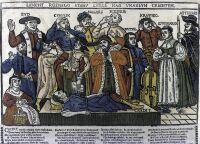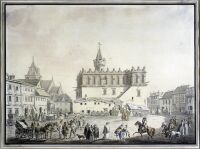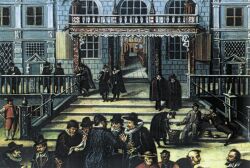





Townspeople (including the Jews) of various professions from the end of the 16th century. Anonymous coloured woodcut "Lamentation of people of various classes over the dead credit" with the versed text below, is a very popular form of satire on economic relations in the First Republic, where the economic activities depended on the loans provided i.a. by the Jewish bankers.
Jewish physicians treat the townsman. Anonymous painting "Healing of the unknown townsman from Kraków", 2nd half of the 17th century, the Chapel of the Blessed Isaiah Boner, the gallery of the st. Catherine Church in Kraków. The Jewish physicians were highly esteemed for their expertise gained at the foreign universities, and sent for regardless of the class or religion of the sick (including the clergy and kings).
Jews at the horse market, drawing by Jan P. Norblin, ca. 1790.
Horse and ox trade were among the jobs often taken up by the Jews, and particularly by their kinsfolk - Karaites.
Kohen Tobias Rofe (1653-1729), physician and philosopher. He was born in Narol; studied medicine in Frankfurt on the Main and Padua; author of an encyclopaedic work, Maasei Tubia (Venice 1707). |

Market square and town hall in Tarnów, painting by Zygmunt Vogel, 1800.
The Jewish merchants and craftsmen were noticeable in almost every town of the old Poland. They gathered at market squares, where on market day they arrived from naighbouring towns and villages, looking for the potential customers.
"Baal Shem Tov" Yisrael ben Eliezer (1700-1760), drawing, author unknown.
Founder of Hasidism, Jewish religious movement for the most part gathering the poor from Wołyń and Podole. He preached, that one should try to find God in every aspect of life, particularly in joyful ecstasy full of singing and dancing.
Jewish barber, painting by Jan P. Norblin, ca. 1811.
Apart from the lease of the landlord's estates, the Jews provided various services for the noblemen's manors. They worked as barbers, glaziers, goldsmiths and haidressers.
Jacob Leibovitch Frank (1726-1791), drawing, author unknown.
Founder of Frankism - mystical, cabbalistic movement that appeared in Podole in the mid 18th century. He rejected Talmud and proclaimed himself a messiah. Assaulted by the orthodox Jews, he converted into islam, and eventually into Catholicism. For accepting baptism the Frankists were ennobled, but later they were assaulted by the part of the Polish Roman Catholic clergy. After the Frank's death the movement collapsed.
|

Jewish merchants trade with the Christian merchants in Gdańsk. Part of the painting by Isaac van den Blocke "The Apotheosis of Danzig" from the beginning of 17th century. The Jewish brokers, eployed by the noblemen, floated corn, wood, ashes and forest products on the Vistula river.
Because of the general literacy of the Jewish minority, Polish nobility and clergy often employed the Jews as real estates' administrators or tax, toll or duty collectors. Their economic significance aroused ill-will of townspeople and peasants.
Trade and craft were the main jobs of the Jewish population (they worked as tailors, carpenters, goldsmiths, printers, etc.) as well as providing loans. Many of them were in service at noblemen's or magnate's manors and even at the royal court; some were physicians or apothecaries.
As a result of the wars of the 17th century, Poland suffered from economic recession, that lead to pauperization of the Jewish population as well. Many of the Jews suffering from poverty, found consolation in the new religious movements. Among them there was Yisrael ben Eliezer from Podole, who at the half of the century created the movement called Hasidism. In that charismatic orator joyful religiosity joined with the messianic and mystic idea
Little Jewish shop at the Elektoralna Street in Warsaw, drawing by Jana P. Norblin, 1787. The Jewish trade enterprises were very diverse: there were big trading-posts with national and international business activity, and small shops providing lokal markets with the necessary products. |

